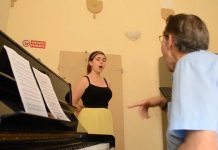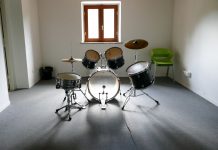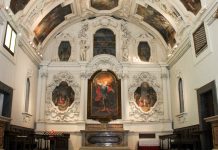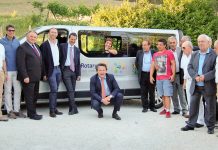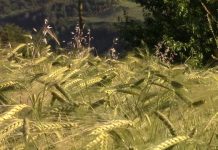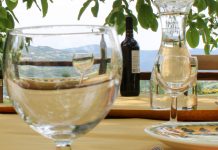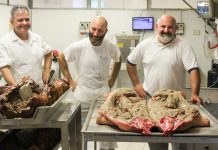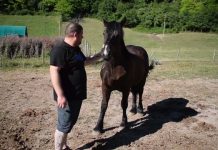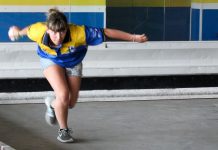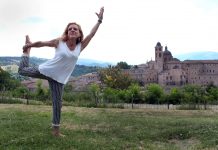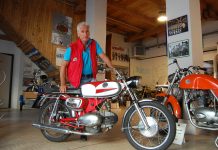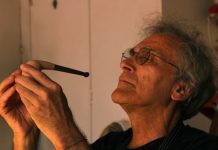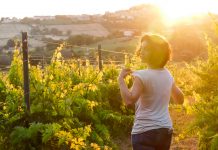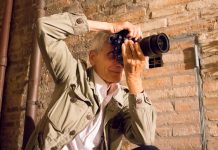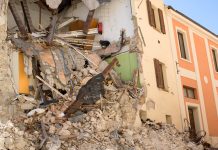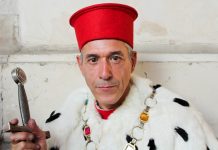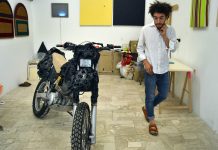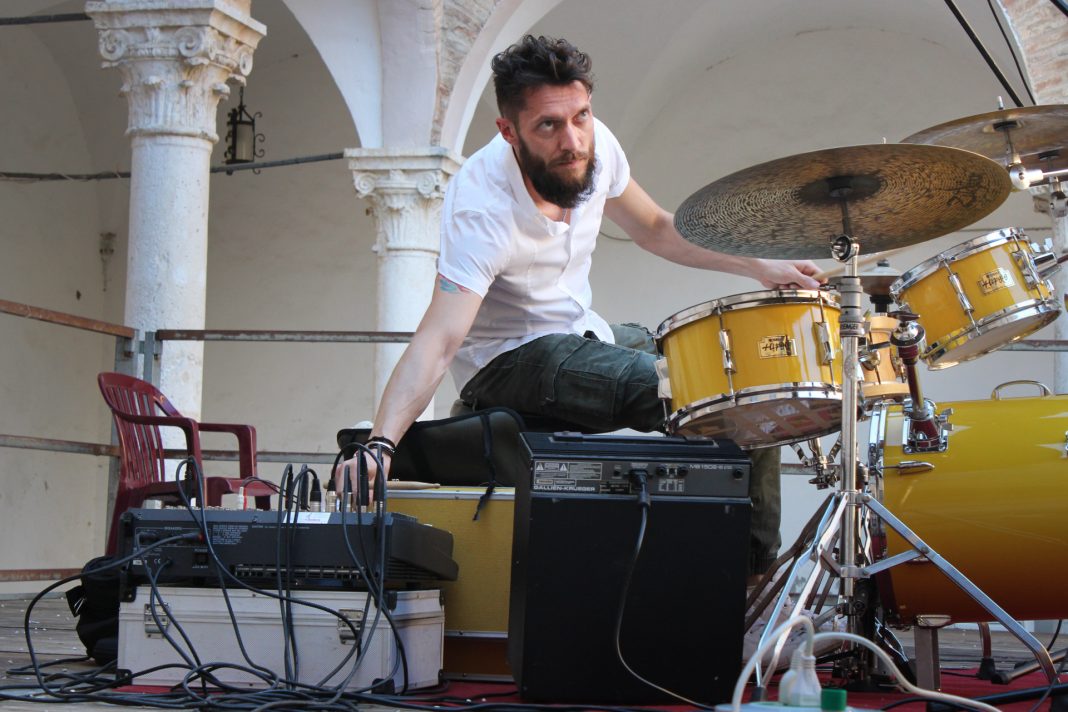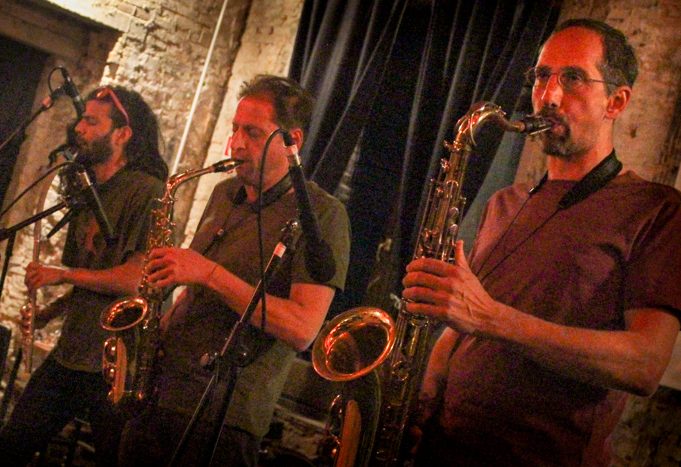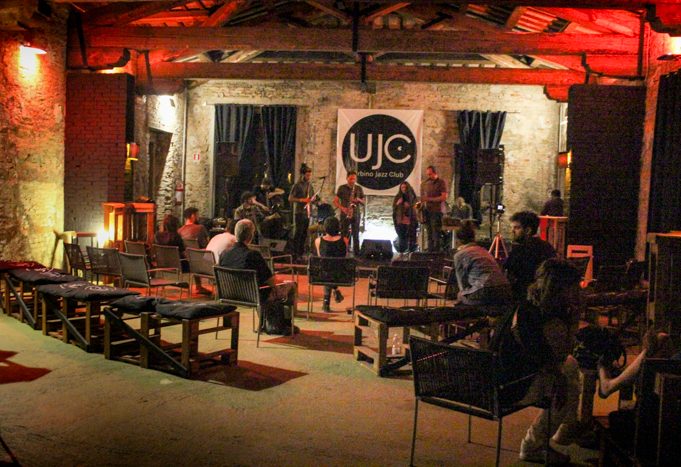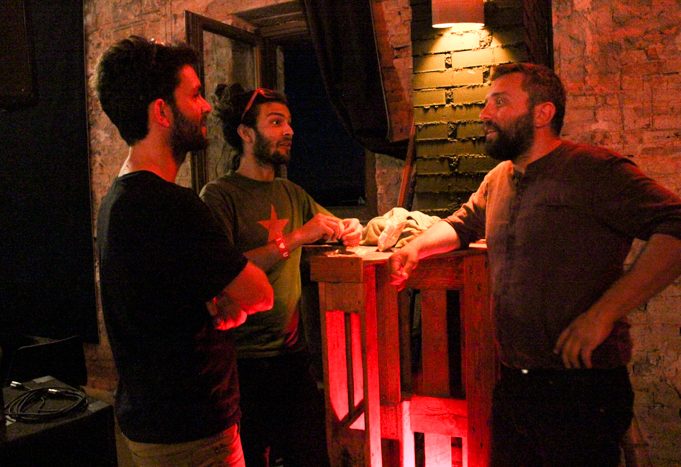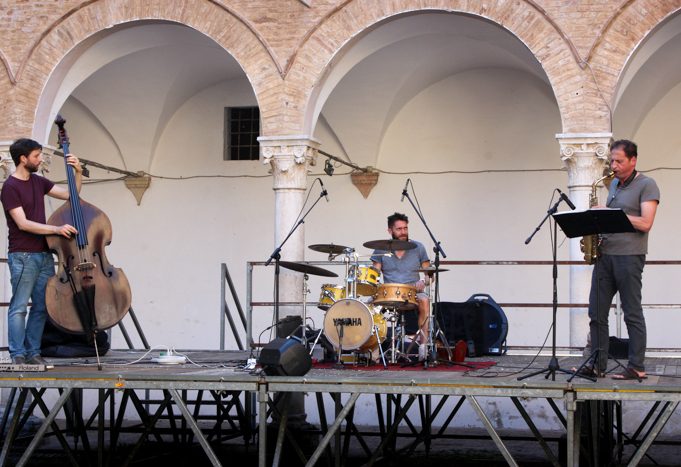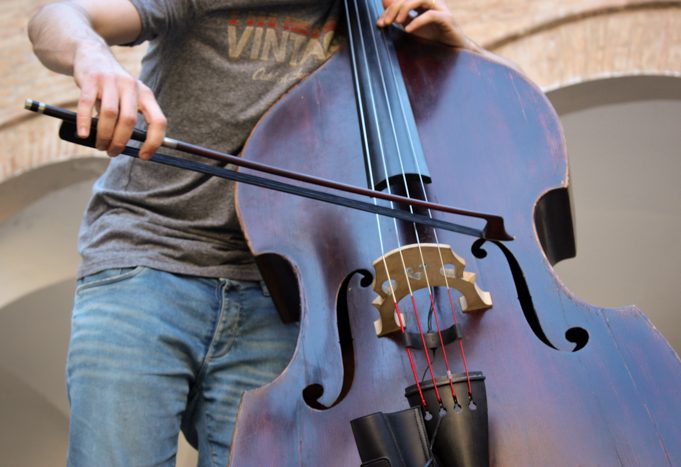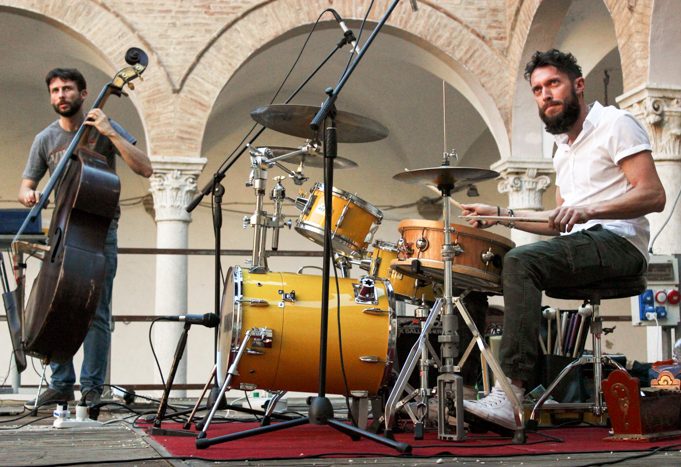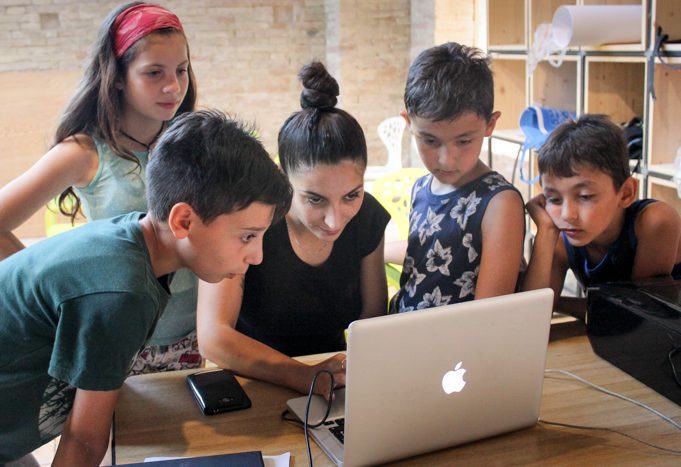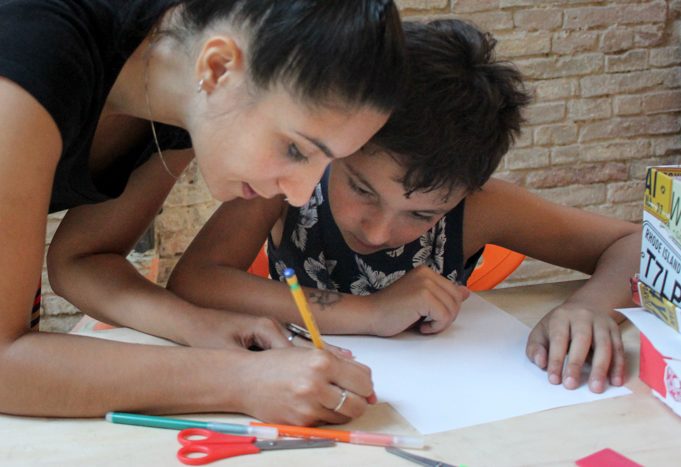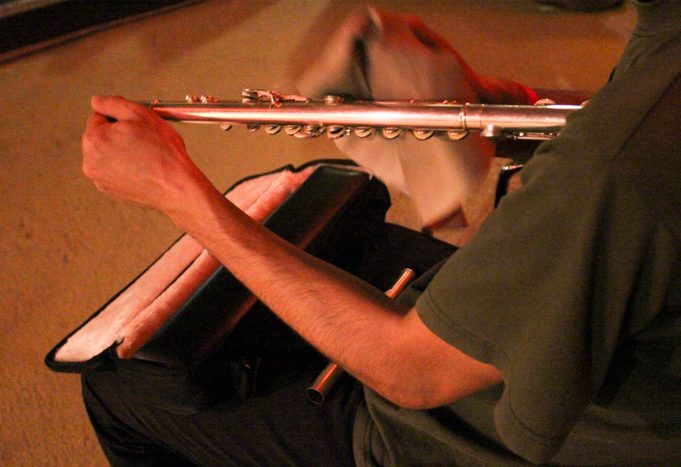The Urbino Jazz Club spreads music and culture throughout the Montefeltro region
In the evening light of a June day in Urbania, the rhythmic beats of a trio of saxophone, double bass/electronics, and drums envelop the Cortile Del Palazzo Ducale, the courtyard of the ducal palace. “We try to play as if we had more musical instruments,” says saxophonist Giovanni Ferri, the leader of the band Strada. “The sax can also become a flute, an electric guitar. The double bass can be a guitar or violin.” With roots in theater and painting, Ferri explains that the band’s composition is based on the drama of storytelling. “The pieces therefore move from jazz to tango, running as a train through the Far East”.
Despite the casual atmosphere—the courtyard venue holds just a few rows of plastic chairs and a temporary stage—this synthesis of musical genres, storytelling, and improvisation seems to intrigue the audience. Spectators of all ages cannot help but sway, bop, or tap to the jazz-like tunes mixed with Latin tango, Eastern European folk known as klezmer, and bossa nova dance music.
This evening’s concert, one of a series called Musica D’Autore, is partly sponsored by a music venue located 32 miles from Urbania—the Urbino Jazz Club. In fact, Urbino’s jazz club hosts many musical and artistic activities throughout the year. Lately, however, the club is more active in locations outside its own walls. With a growing membership and connections to nearby towns like Urbania, the club has been organizing concerts and events in satellite locations around the Montefeltro region.
In early 2014 the founders of the club, trumpeter Denis Fattori, Riccardo Conte, guitarist Jacapo Mezzanotti, and bassist Alex Gorbi envisioned a cultural center where people of all ages could meet to play and share music. “There was no jazz club or musical club where you can really meet,” explains Gorbi, the club’s first president. “There are lots of bars and lots of pubs, but that’s different.” The Urbino Jazz Club would be the first place solely dedicated to music. It would offer and promote American jazz as well as improvisational music in general.

On July 30, 2014, the non-profit Urbino Jazz Club Association was created to build a community to support the ideals of the club. The founders arranged nine concerts for a mini festival, Jazz al Caffe del Teatro, on August 8, 9 and 10, where they promoted the association by selling 10-euro membership cards. To the founders’ surprise, about 150 people bought cards and attended the festival.
By 2015 the association had an agreement with Urbino’s city administration: in exchange for organizing a free festival called Urbino Plays Jazz on August 4, 5, and 6, the city would provide them with the biggest space they could find on via Valerio, the newly branded “street of the arts.” A brick and wooden building that previously had been the Valerio kindergarten seemed like the perfect location. The club would be up a steep set of stairs and across from ceramic artist Marcello Pucci.
On Via Valerio during a calm evening this past June, a faint whining of instruments can be heard. Inside the Urbino Jazz Club, names have been drawn at random to create various musical ensembles. Now, nine people with varying experience levels and backgrounds wrestle for beat and harmony as they play together for the first time.
Glowing under the red lights of the club, a saxophonist, bassist, drummer, flutist, electronic producer, singer, and musical saw player push the boundaries of each instrument’s capabilities. To the untrained ear, these slide-whistle sounds, frantic beats, and screeching outbursts may resemble the soundtrack to a suspenseful space odyssey movie. With furrowed brows, audience members clap hesitantly as the amplified saw emits a last jarring shriek.
Lorenzo Binotti, the organizer of this series of three improvisation laboratories at the jazz club, explains what these musicians try to accomplish in these short experiments. “It works on sound, rhythmic, and gestural articulation of music,” he says. “It’s timbre, and the interaction between acoustic and electronic sound.”
A few weeks following the improvisation lab, another Urbino Jazz Club concert unfolds outside the walls of the club in the Cortile del Collegio Raffaello, just a couple of blocks away. Singer Nicola Gaggi theatrically belts out swing music of the ’40s and ’50s, while Marco Di Meo, with a calm, collected grin, strums his guitar. Between songs, Gaggi, with eyes wide, eyebrows raised, and an upward curve in his lips, invites the audience to experience the fantastical stories he describes. Watching the duo is like watching an old Charlie Chaplin movie, but with added verbal storytelling and songs.
Singing along to the well-known tunes, snapping their fingers, and tapping their feet to the beat, it seems that the crowd of around 15 can easily relate to this music, unlike the seemingly unworldly music of the improvisation lab.
Appreciative audiences and a suitable physical space are not the only kinds of support the club has received from the community. When it first moved into the Via Valerio building, local companies such as Circateatro (a theater group), Stocchi Jeans, and Central Tubi (a polyethylene pipe company), worked closely with the association, donating seat cushions, fabric for curtains, and palettes of wood for tables for the new club.
Now the jazz club has gained many sponsors, including well-known Italian singer and pianist Raphael Gualazzi, who played for free with vibraphonist Daniele Di Gregorio at the first concert of the Jazz al Caffe del Teatro Festival. Local businesses such as Hotel Mamiani and Hotel Raffaello provide housing for the musicians who travel from out of town to play at the club, while Ristorante la Balestra and Ristorante la Terrazza del Duca provide food.
“I put my own idea of jazz into this club and my idea of jazz is that everything that is improvisation is jazz,” says Urbino Jazz Club artistic director Massimo Valentini.
Artistic Director Massimo Valentini’s vision is what guides the club’s musical and cultural decisions. “I put my own idea of jazz into this club and my idea of jazz is that everything that is improvisation is jazz,” he says. His broad concept may explain the wide variety of recent musical events and outside venues. The club’s activities in June ranged from the series in Urbania to the “free jazz” improv labs to symphonic and swing performances—and even a series of classes to teach children “experimental animation” for film. Running for nearly a month in La Data, a section of underground rooms of Urbino’s Ducal Palace, the classes enabled students to create colorful abstract graphics, sand art, and drawings as part of an animated visual accompaniment to Mozart’s The Magic Flute.
Valentini lists several reasons for the club’s expansion to satellite locations within and beyond Urbino. He says that for now the club can no longer afford any more events at Via Valerio because it hosted so many activities in the early part of 2017. Also, since it has no air conditioning, the club is not suitable for the hot June weather of Urbino; outdoor concerts, produced with other associations and communities, make more sense. Lastly, the club needs to focus its efforts on another festival, scheduled for August.
Despite this quiet period at the Via Valerio venue, Valentini says the Jazz Club has seen exponential growth in the past two years. Membership in the association has increased from 300 to nearly 600. In the five months that he has been working with the club, they have planned 13 concerts. He adds that thanks to recent permission from the city of Urbino, the club can now admit up to 100 people in the building, while it previously was allowed only 60.
“We have a good team at the jazz club,” says Valentini. “Everyone is working for its growth, but it can be done even better. I hope that the administration and also the citizens of Urbino continue to give us the support they have given us so far.”
Riccardo Conte, the current president of the club, believes that the connections made and communication among members of the association are the most fundamental part of the organization. He says, “Music is just a vehicle for people to speak and communicate.”
Conte says that since the club can no longer rely on free or inexpensive entry fees and the small profit from selling drinks at the bar, the plan is to get more funding from European companies such as Music In, a music store in San Marino. The club will also continue the collaboration with Central Tubi and Stochhi Jeans. And as a full-time financial consultant at Banca Marche, Conte says that in a year or two he will step down from being president of the club to concentrate on handling the finances. Once the club gets more funding, renovations and new equipment such as stage lights and amplifiers are on the shopping list.
Looking farther ahead—”even if Massimo [Valentini] and I aren’t in the association,” Conte says, “I hope that this place can continue to communicate forever.”
Slideshow
This article also appears in Urbino Now magazine’s Urbino Centro section. You can read all the magazine articles in print by ordering a copy from MagCloud.


